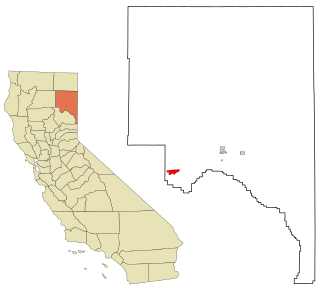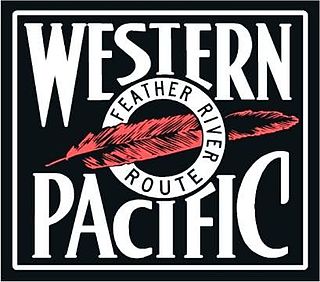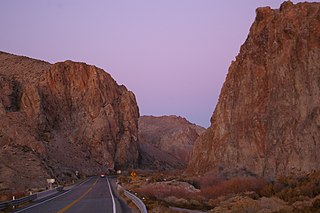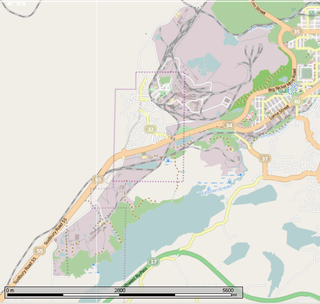
Westwood is a census-designated place (CDP) in Lassen County, California, United States. Westwood is located 20 miles (32 km) west-southwest of Susanville, at an elevation of 5,128 feet. Its population is 1,541 as of the 2020 census, down from 1,647 from the 2010 census..

The Nevada Northern Railway was a railroad in the U.S. state of Nevada, built primarily to reach a major copper producing area in White Pine County, Nevada. The railway, constructed in 1905–06, extended northward about 140 miles (230 km) from Ely to connections with the Western Pacific Railroad at Shafter and Southern Pacific Railroad at Cobre. In 1967 NN reported 40 million net ton-miles of revenue freight on 162 miles (261 km) of line.
The BHP Nevada Railroad was a shortline railroad that operated in Nevada from 1996 to 1999. BHP acquired the line from Nevada Northern Railway. Constructed by Utah Construction Company in 1908, the railroad hauled copper ore concentrate from BHP's concentrator at Riepetown to Shafter, Nevada. At Shafter the railroad interchanged with the Union Pacific and the ore continued to BHP's smelter at San Manuel, Arizona. BHP is an Australian-based company that took over Magma Copper, the owner of the Robinson Mine at Ruth, Nevada, in January 1996. The line ran south from a connection with the Union Pacific at Shafter to Ely.

The Diamond and Caldor Railway was a common carrier 3 ft narrow gauge railroad operating in El Dorado County, California, in the United States. The 34-mile railroad was primarily a logging railroad but also operated some passenger service.

The McCloud Railway was a class III railroad operated around Mount Shasta, California. It began operations on July 1, 1992, when it took over operations from the McCloud River Railroad. The MCR was incorporated on April 21, 1992.
The Santa Maria Valley Railroad is a 14.8 miles (23.8 km) shortline railroad that interchanges with the Union Pacific Railroad's Coast Line at Guadalupe, California. As of 2006, the Railroad is owned by the Coast Belle Rail Corporation.

The San Pedro Valley Railroad, formerly the San Pedro & Southwestern Railroad, is an Arizona shortline railroad, currently operating from a connection with the Union Pacific Railroad (UP) at Benson, Arizona, seven miles to Curtiss, Arizona west of St. David. The SPSR formerly ran a total of 76.2 miles (122.6 km), with main track from Benson to Paul Spur, a location about 10 miles (16 km) west of Douglas, as well as the Bisbee Branch which ran 5.6 miles (9.0 km) to Bisbee, Arizona. The SPSR is owned by Ironhorse Resources.

The Indian Valley (IV) Railroad was a shortline railroad that was constructed from the Engels Copper Mine to a connection with the Western Pacific Railroad at Paxton, in Plumas County, northeastern California.

The Camino, Placerville and Lake Tahoe Railroad was an 8-mile (13 km) Class III short-line railroad operating in the Sierra Nevada in California, east of Sacramento. It was built primarily to haul lumber from the El Dorado National Forest. The standard gauge line ran west 8.05 miles (12.96 km) from a sawmill at Camino to a connection with the Placerville Branch of the Southern Pacific Company at Placerville. Loaded cars of lumber descended a 3.5 percent grade from 3,150 feet (960 m) at Camino to 1,900 feet (580 m) at Placerville.

The Feather River Route is a rail line that was built and operated by the Western Pacific Railroad. It was constructed between 1906 and 1909, and connects the cities of Oakland, California, and Salt Lake City, Utah. The line was built to compete with the Southern Pacific Railroad, which at the time held a nearly complete monopoly on Northern California rail service. The route derives its name from its crossing of the Sierra Nevada, where it follows both the North and Middle Forks of the Feather River. The route is famous for its impressive engineering qualities and its considerable scenic value. All of the route is now owned and operated by the Union Pacific Railroad; however, the Union Pacific has transferred significant portions of the route to other lines. The portion still called the Feather River Route by the Union Pacific runs from the California Central Valley to Winnemucca, Nevada and has been divided into three subdivisions named the Sacramento, Canyon and Winnemucca subdivisions.
The El Paso and Southwestern Railroad began in 1888 as the Arizona and South Eastern Railroad, a short line serving copper mines in southern Arizona. Over the next few decades, it grew into a 1200-mile system that stretched from Tucumcari, New Mexico, southward to El Paso, Texas, and westward to Tucson, Arizona, with several branch lines, including one to Nacozari, Mexico. The railroad was bought by the Southern Pacific Railroad in 1924 and fully merged into its parent company in 1955. The EP&SW was a major link in the transcontinental route of the Golden State Limited.
The Sacramento Valley and Eastern Railway (SV&E) was a railway company that operated in Shasta County, California from 1908 until the early 1930s.

The Diamond Match Company is a brand of matches and toothpicks, and formerly other wood products and plastic cutlery, that has its roots in a business started in 1853 by Edward Tatnall in Wilmington, Delaware. Ownership passed to William H. Swift and Henry Courtney who operated under the name Swift & Courtney and marketed their product as Diamond State Parlor Matches.

Wilson Canyon is a gorge cut by the Walker River through a series of volcanic cliffs. The canyon is located 13 miles (21 km) west of Yerington, along Nevada State Route 208. It is managed by the U.S. Bureau of Land Management.

The Vale Railway, formerly the INCO Railway, is an industrial railway operating in the City of Greater Sudbury, Ontario, Canada. It is owned and operated by Vale Limited.
The Algoma Eastern Railway was a railway in Northeastern Ontario, Canada. Originally known as the Manitoulin and North Shore Railway (M&NS) with a charter dating back to 1888, the full mainline was opened to traffic in 1913, serving the area along the north shore of Lake Huron between Sudbury and Little Current on Manitoulin Island. It and its sister railway, the Algoma Central, were originally owned by the Lake Superior Corporation, a conglomerate centered on Sault Ste. Marie which was founded by the American industrialist Francis Clergue. Despite ambitious plans to expand across Lake Huron to the Bruce Peninsula using a railcar ferry, the company failed to develop further and was acquired by the Canadian Pacific Railway in 1930. With freight traffic low during the Great Depression, Canadian Pacific soon abandoned much of the Algoma Eastern mainline in favor of its own Algoma Branch. Remaining sections of the Algoma Eastern line were turned into spurs, with the longest surviving section operated as a branch line known as the Little Current Subdivision.
The Michigan-California Lumber Company was an early 20th-century Ponderosa and Sugar pine logging operation in the Sierra Nevada. It is best remembered for the Shay locomotives used to move logs to the sawmill.

Ludwig, Nevada is a ghost town in Lyon County, Nevada, United States. Mining for gypsum at the site resumed in 2013.












